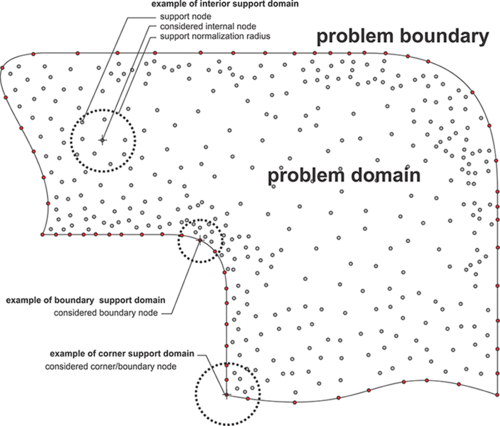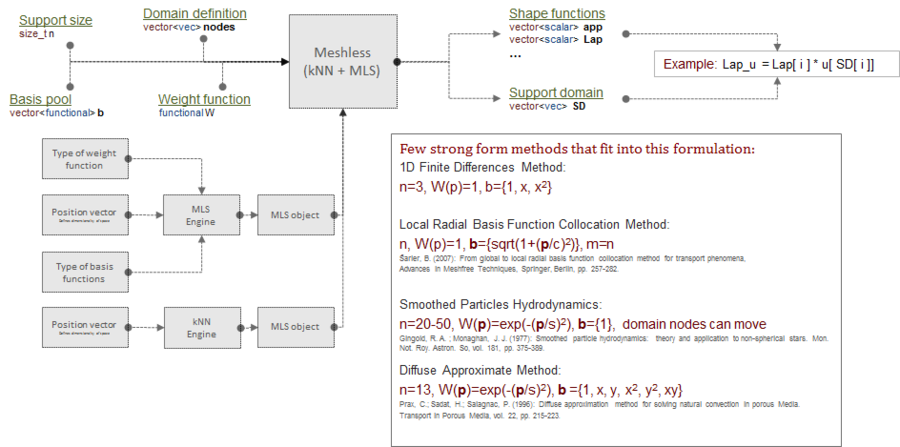Meshless Local Strong Form Method (MLSM)
The Meshless Local Strong Form Method (MLSM) is a generalization of methods which are in literature also known as Diffuse Approximate Method (DAM), Local Radial Basis Function Collocation Methods (LRBFCM), Generalized FDM (GFDM), Collocated discrete least squares (CDLS) meshless, etc. Although each of the named methods has some unique properties, the basic concept of all local strong form methods is similar, namely to approximate differential operators as
weighted sums of function values over the local support domain. MLSM can be understood as a generalization of FDM to scattered nodes, however much more powerful.
The elegance of MLSM is its simplicity and generality. The presented methodology can be also easily upgraded or altered, e.g. with nodal adaptation, basis augmentation, conditioning of the approximation, etc., to treat anomalies such as sharp discontinues or other obscure situations, which might occur in complex simulations. In MLSM, the type of approximation, the size of support domain, and the type and number of basis function is general. For example, minimal support size for 2D transport problem is five, however higher support domains can be used to stabilize computations on scattered nodes at the cost of computational complexity. Various types of basis functions might appear in the approximation, however, the most commonly used are multiquadrics, Gaussians and monomials. Some authors also enrich the radial basis with monomials to improve performance of the method (see Radial basis function-generated finite differences (RBF-FD)). All these features can be controlled during the simulation. From the computation point of view, the localization of the method reduces inter-processor communication, which is often a bottleneck of parallel algorithms.
The core of the spatial discretization is a local Weighted Least Squares (WLS) approximation of a considered field over the overlapping local support domains, i.e. in each node we use approximation over a small local sub-set of neighbouring $n$ nodes. This idea is used to compute the shape functions , which enable us to approximate operators as $$(\mathcal{L}u)(p) = \sum_{i=1}^n c_i u_i.$$
Refer to Weighted Least Squares (WLS) and Computation of shape functions for details about numerical calculation of shape functions / stencil weights $\b c = (c_i)_i$.
The presented formulation is convenient for implementation since most of the complex operations, i.e. finding support nodes and building shape functions, are performed only when nodal topology changes. To evaluate the desired operator in the main simulation, only a dot product of the pre-computed shape functions with the vector of field values in the support needs to be computed. The presented approach is even easier to handle than in FDM, however, despite its simplicity it offers many possibilities for treating challenging cases, e.g. nodal adaptivity to address regions with sharp discontinuities or $p$-adaptivity to treat obscure anomalies in physical field, furthermore, the stability versus computation complexity and accuracy can be regulated simply by changing number of support nodes, etc. All these features can be controlled during the simulation by re computing the shape functions with different setups. However, such re-setup is expensive, since shape functions have to be re-evaluated, with complexity of $O(N nm^2)$, where $N$ stands for total number of discretization nodes. In addition, the determination of support domain nodes also consumes some time, for example, if a kD-tree data structure is used, first the tree is built with $O(N \log N)$ and then additional $O(nN\log N)$ for collecting $n$ supporting nodes.
References
- Kosec G., A local numerical solution of a fluid-flow problem on an irregular domain. Advances in engineering software. 2016;7 ; [29512743] :: manuscript
- Trobec R., Kosec G., Šterk M., Šarler B., Comparison of local weak and strong form meshless methods for 2-D diffusion equation. Engineering analysis with boundary elements. 2012;36:310-321; manuscript
- Kosec G, Sarler B. Solution of thermo-fluid problems by collocation with local pressure correction. International Journal of Numerical Methods for Heat & Fluid Flow. 2008;18:868-82 manuscript
- Trobec R., Kosec G., Parallel Scientific Computing, ISBN: 978-3-319-17072-5 (Print) 978-3-319-17073-2.

